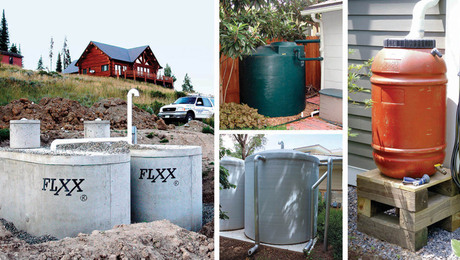Down the drain
A lot of people are surprised to learn that there is a finite amount of water on the planet
In a rare moment of good sense, the U.S. Congress passed, and President George H.W. Bush signed into law, the Energy Policy Act of 1992. By setting limits on how much electricity refrigerators can use, by establishing efficiency thresholds for furnaces, and by addressing water consumption of plumbing fixtures, the law—known as EPAct—has allowed the United States to avoid building dozens of new power plants while eliminating hundreds of supertankers of oil imports and trillions of gallons of water consumption annually.
Among its provisions, EPAct established a maximum flow rate for showerheads of 2.5 gallons per minute (gpm). Unfortunately, EPAct addresses only individual showerheads, not showers. You can circumvent the intent of the law by putting in multiple showerheads, which is exactly what’s happening in more and more custom homes.
In slick ads, curvaceous models entice you to buy multihead shower systems that place you under a waterfall in the privacy of your bathroom or surround you with a torrent of water from up to a dozen spray nozzles. Some systems use more than 20 gallons of water per minute, a small portion of which may briefly contact your body en route from your water heater to your sewer line. Like outdoor air conditioners in the courtyards of Saudi oil sheiks, these systems are textbook examples of profligate waste.
Nobody is making any new water
A lot of people are surprised to learn that there is a finite amount of water on the planet, and that we cycle through that same water over and over. The renewable water supply for a given watershed, roughly speaking, is the amount of water available from precipitation. This amount is the water that theoretically could be used on a sustained basis.
Throughout the Eastern United States, water consumption is less than 10% of the renewable supply. But in the West, water supplies are far less plentiful. In the Lower Colorado Basin, which covers most of Arizona and parts of New Mexico and Nevada, water consumption is actually greater than the renewable supply. Cities like Albuquerque and Las Vegas are projected to fall short of their water needs in the next 10 to 20 years, even without continued droughts. It is remarkable that water conservation isn’t a higher priority in these areas.
The need for water conservation isn’t limited to the South-west, however. Many areas of the United States experience periodic droughts and localized pressure on water supplies. Bans on lawn-watering in Florida, New Jersey, and the upper Midwest are not uncommon. In fact, the first statewide water-conservation standards in the country, passed in 1987, were adopted not in Arizona but in Massachusetts because of shortfalls from its primary water supply, the Quabbin Reservoir. That Massachusetts law became the model for the federal legislation.
Who needs 80 gallons per minute?
The federal law, however well intentioned, didn’t anticipate the entrepreneurial wiles of plumbing manufacturers or the lust of some homeowners for hydraulic luxury. One leading manufacturer offers a $2700 “vertical spa set” with a large-diameter four-function showerhead, four body-spray nozzles, and a handheld shower, each rated at 2.5 gpm. Another offers a $4500 system with a half-dozen showerheads and body-spray nozzles, each of which meets the federal 2.5-gpm standard.
At least one European manufacturer suggests that what it’s selling isn’t a shower at all. The company’s brochure states that for the United States and Canada, the product “is not designed for or intended to be used in any circumstance as a plumbing device, shower system, or for use in violation of any applicable law.” The fact that a naked woman is shown being drenched by a ceilingmounted rain panel must be purely coincidental.
Manufacturers of such systems warn of overwhelming a home’s infrastructure. With multiple valves, some custom shower systems can deliver 32 gallons of water per minute—enough to fill a standard 5-ft. bathtub every minute. A leading plumbing-valve manufacturer recommends at least a 100-gallon water heater. Manufacturers recommend dedicated 3⁄4-in. or even 1-in. supply lines from the water heater. Draining these systems adequately requires two 2-in. floor drains or one 3-in. drain. In rural areas, a home’s wellwater supply may not keep up with the flow of custom shower systems, and the septic tank may not be able to handle the effluent.
A number of systems on the market, including one that delivers up to 80 gpm, use a recirculating pump with an integral heater. The reason for this is that a reasonably sized water heater simply can’t keep up with that level of water flow. For those needing nearly three bathtubs’ worth of water per minute, the recirculating pump is probably a good thing, using a lot less water and energy than a once-through system.
Water belongs to all of us
Al Dietemann, the water-conservation program leader at Seattle Public Utilities, notes that “for every three people that put in these shower systems, it negates the efforts of 100 people putting in efficient products.” Those who partake of this profligate use of water need to realize that their excesses affect the rest of us. Just as second-home owners in Aspen who install half-million-Btu driveway-snowmelt systems now have to pay an impact fee that funds energy-conservation or renewable-energy programs to offset the burdens of those driveway heaters, perhaps homeowners who put in 20-gpm shower systems should pay impact fees to fund waterconservation programs.
Alex Wilson is president of BuildingGreen Inc. ( www.buildinggreen.com ) and executive editor of Environmental Building News. His book, Your Green Home, was published recently by New Society Publishers.
Fine Homebuilding Recommended Products
Fine Homebuilding receives a commission for items purchased through links on this site, including Amazon Associates and other affiliate advertising programs.

A Field Guide to American Houses

Graphic Guide to Frame Construction

All New Kitchen Ideas that Work

























